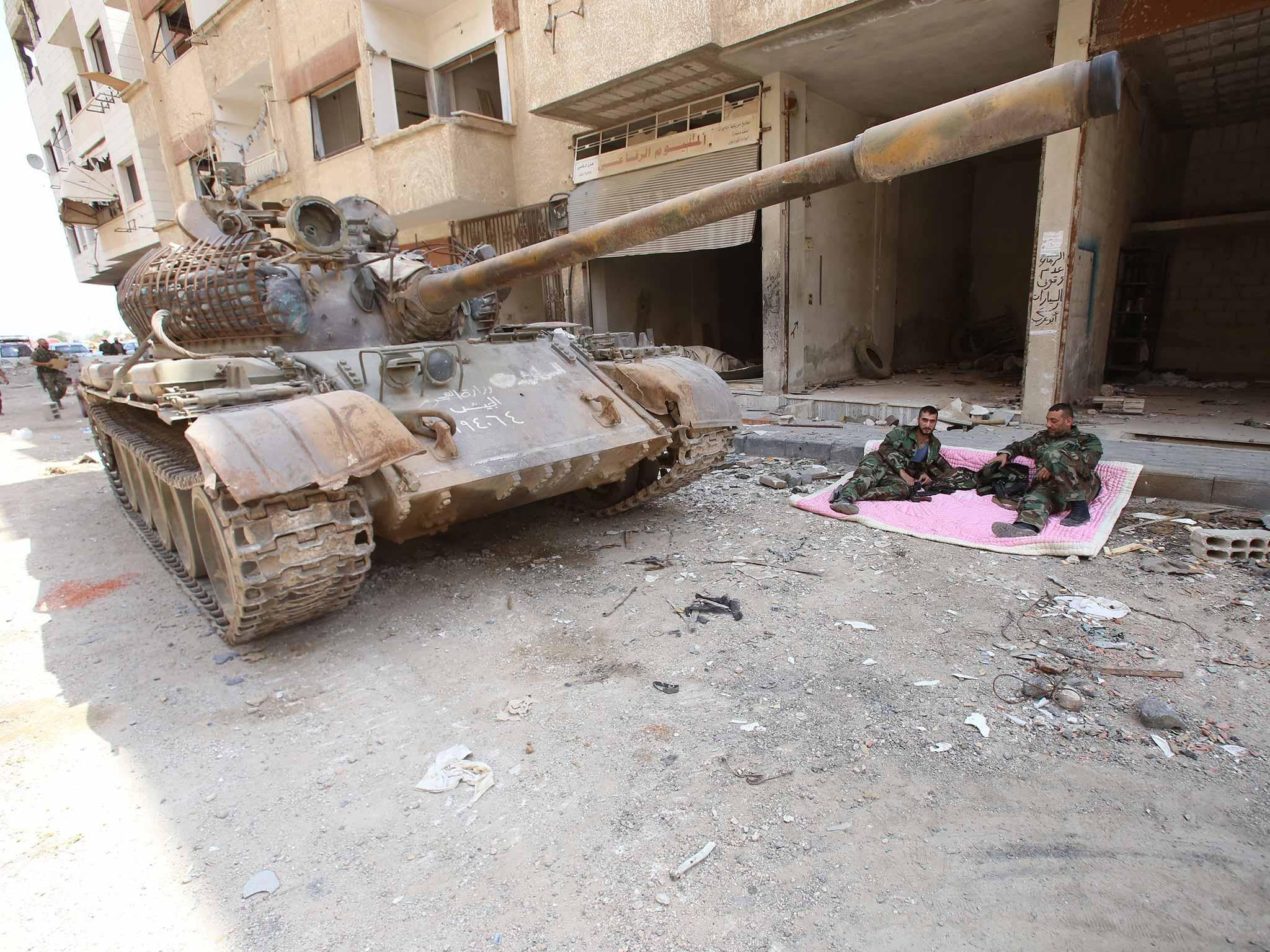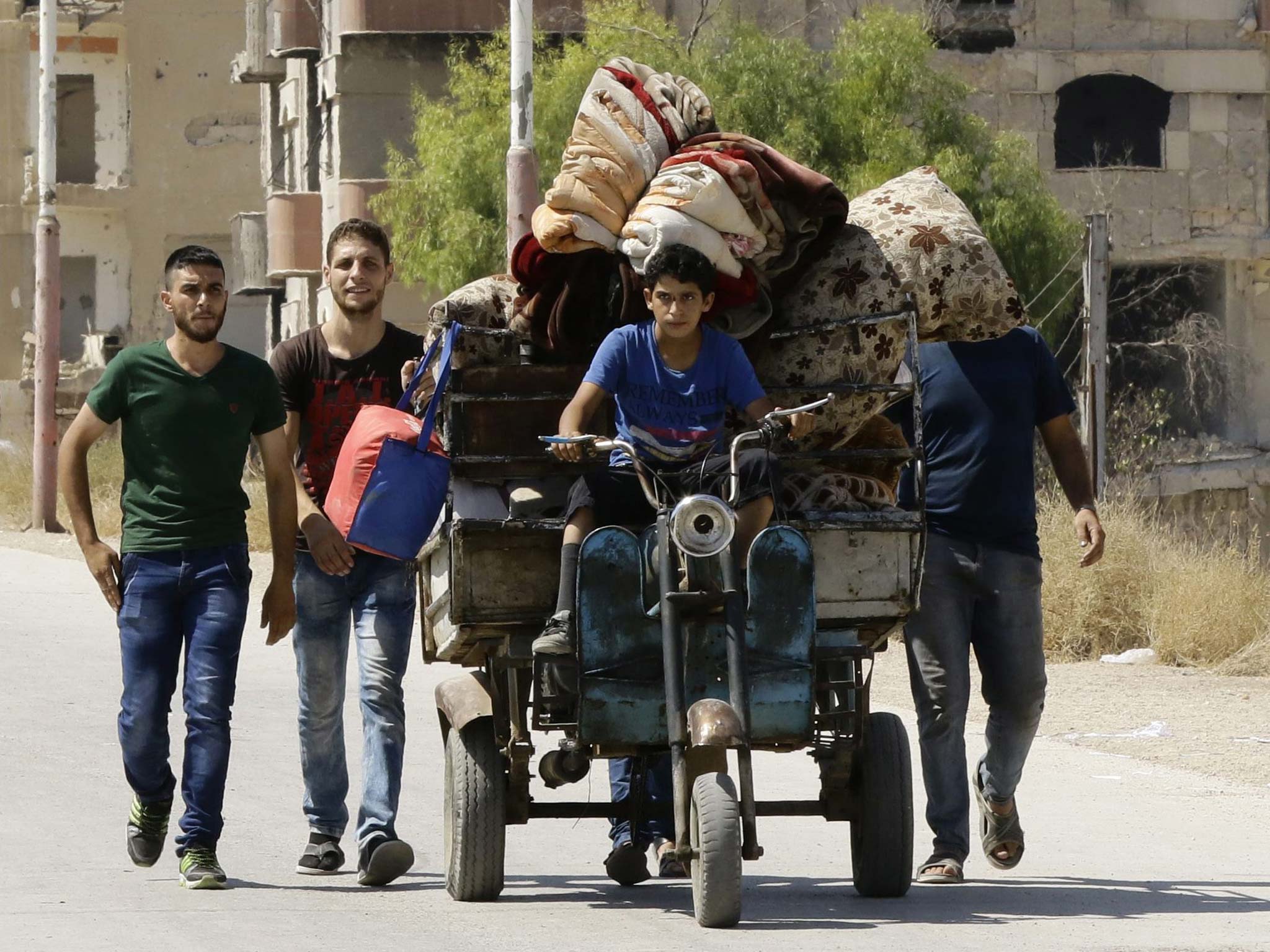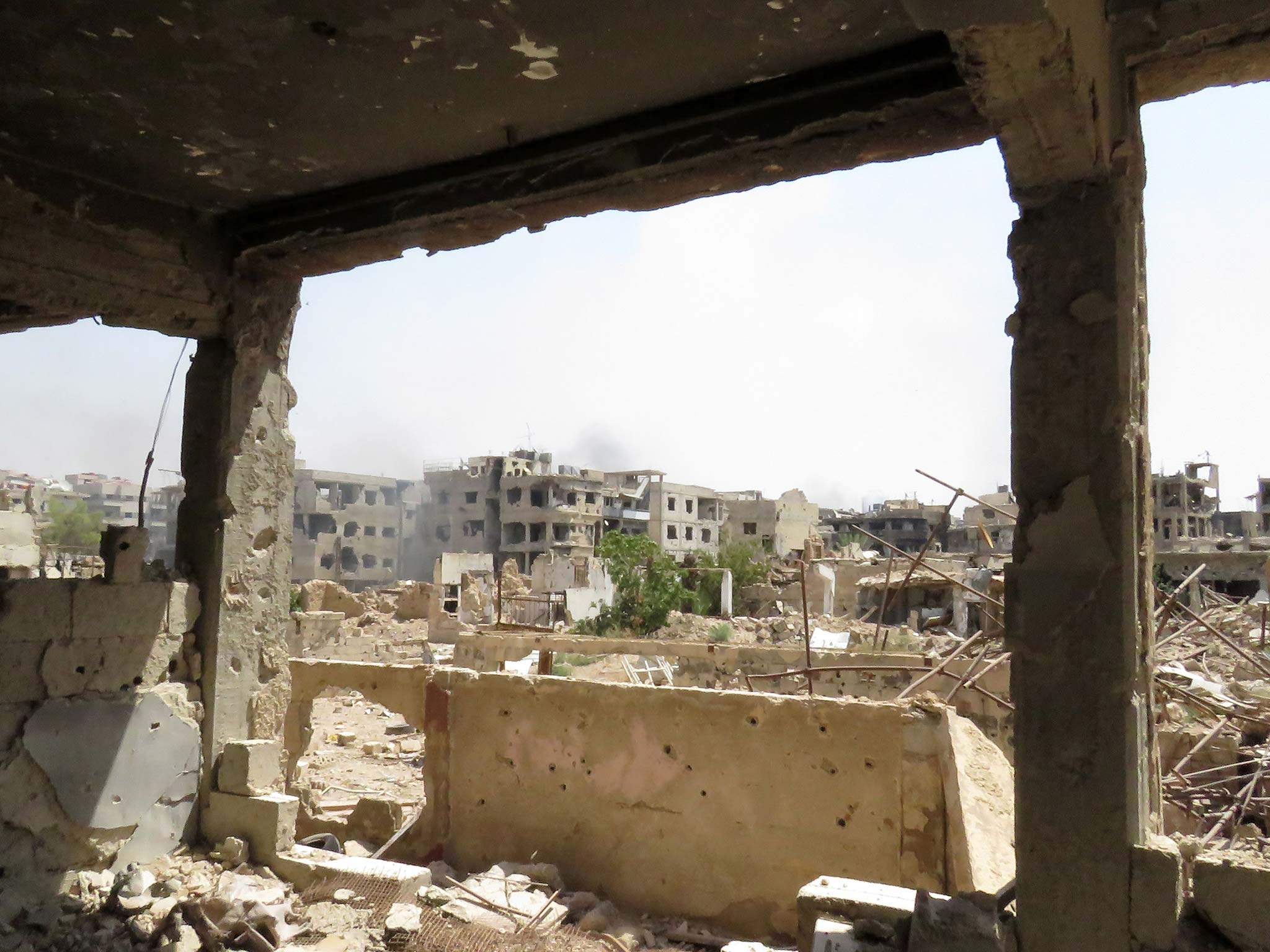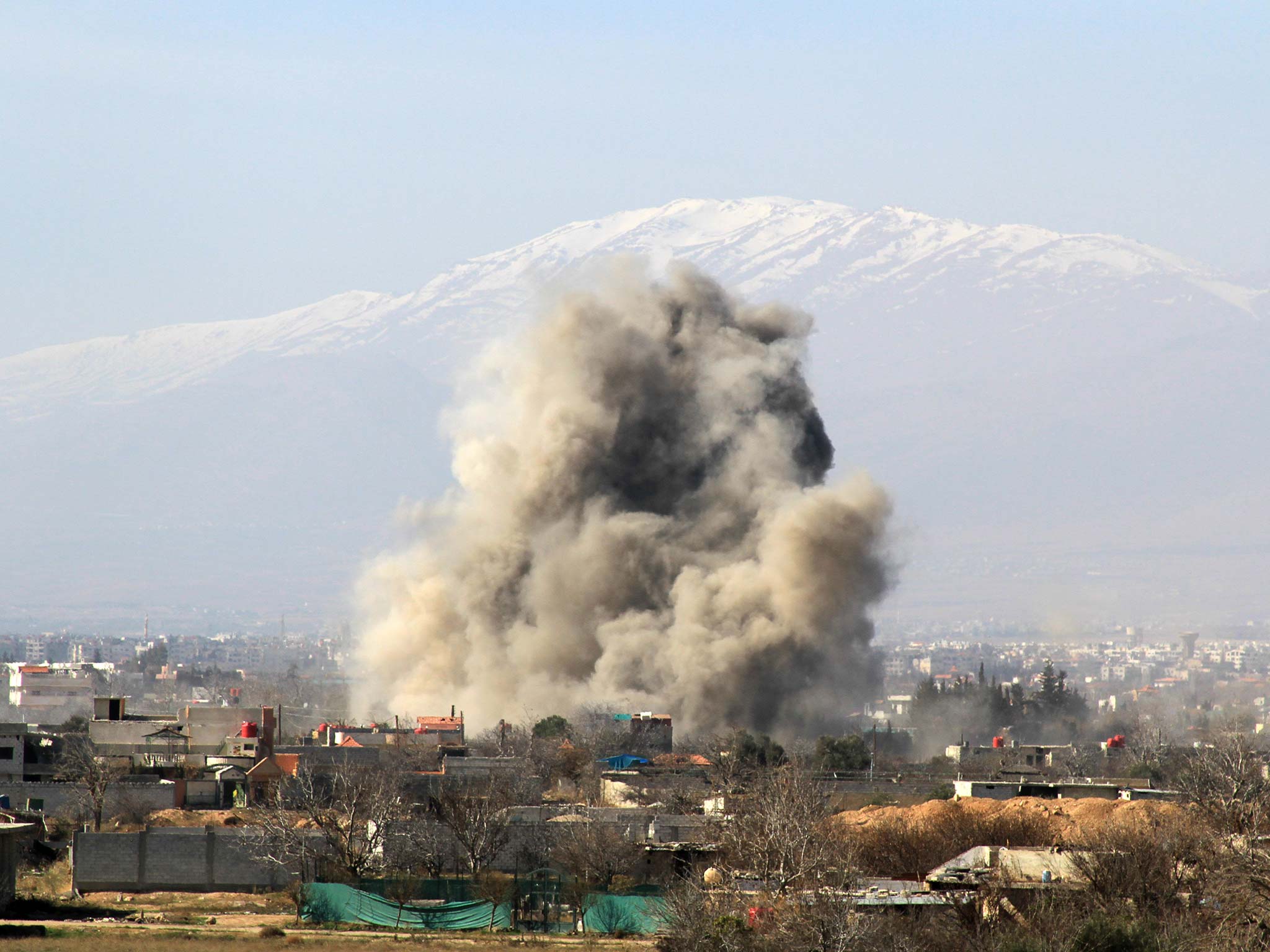The silent devastation of Daraya: Capture of suburb is a big step towards Assad winning the battle for Damascus
In the third part of his series on the Syrian conflict, Patrick Cockburn reports from the ruins of a Syrian town after the end of a four-year siege which provides a telling sign which way the war is heading

Your support helps us to tell the story
From reproductive rights to climate change to Big Tech, The Independent is on the ground when the story is developing. Whether it's investigating the financials of Elon Musk's pro-Trump PAC or producing our latest documentary, 'The A Word', which shines a light on the American women fighting for reproductive rights, we know how important it is to parse out the facts from the messaging.
At such a critical moment in US history, we need reporters on the ground. Your donation allows us to keep sending journalists to speak to both sides of the story.
The Independent is trusted by Americans across the entire political spectrum. And unlike many other quality news outlets, we choose not to lock Americans out of our reporting and analysis with paywalls. We believe quality journalism should be available to everyone, paid for by those who can afford it.
Your support makes all the difference.A small triangular green flag with the words “there is no God but God and Mohammed is his Prophet” inscribed on it is stuck in a heap of smashed masonry half-blocking the street in the former rebel stronghold of Daraya, which fell to government forces two weeks ago at the end of a four-year siege. In a building nearby there is the entrance to a carefully constructed tunnel said to be too dangerous to enter and somebody has written on the wall “the martyrs of Syria are so many that they will build a new Syria in heaven”.
The flag, the tunnel and the message are among the few signs of the fighters who fought for so long for this devastated ghost town in south east Damascus, three miles from the centre of the capital. Its capture by the Syrian Army on 25 August was a decisive moment in the struggle for the Syrian capital, home to one third of the population, or at least five million of the 16 million Syrians still in the country, full control of which is likely to determine who will emerge the victor in the civil war.
The Syrian government is confident it is winning: the resistance of Daraya was a highly-publicised symbol of rebel resistance though only 1,800 fighters and civilians were there at the end. International attention is focused on more distant battlefields in Aleppo or Palmyra, but the tightening government hold on Damascus is a more important development. Four years ago the city was a jigsaw puzzle of pro-government and pro-opposition areas with each side trying to expand their heavily defended islands of authority. But today the government holds almost all of the city and its outskirts aside from a single large opposition enclave to the east, known as East Ghouta. Isolated, starved, bombarded, divided among themselves and sensing that the war is going against them, the rebel townships are surrendering on terms that leaves the government in charge.

The Syrian Army was eager this week to show off its latest success at Daraya, though concerned about booby traps and mines. “We have lost six soldiers dead and four injured defusing them,” said General Ayman Saleh, a field commander in the 4th Brigade that has been besieging the town since 2012. “The devices are attached to doors into rooms, fridges and such like.” Nevertheless, the army must be confident that its grip on the town is complete since four soldiers without their weapons walked past us.
The great majority of the 200,000 people who once lived in the town fled a long time ago, probably in 2012. The degree of visible destruction varies from street to street and neighbourhood to neighbourhood. It is total at the entrance to the town, close to what was once a municipal pound for cars confiscated by the police, where all the buildings are shattered with only the stumps of concrete supporting pillars rising a few feet above the debris. This was once the front line, but further into the town most of the modern apartment blocks are gutted but still standing, often pitted with holes made by bullets and shrapnel. Every so often there is a tangle of broken concrete, window frames and furniture where a shell or a bomb has turned a whole building into a heap of wreckage.
There is complete silence with no people or even signs of recent habitation. Daraya used to specialise in making furniture in small workshops and one occasionally sees the remains of broken wood-cutting machinery. Shop signs are faded, though on one shop front there is a “for sale” sign, the desperate but doomed attempt of some shop owner to find a buyer before his neighbourhood was engulfed by violence. The streets are long canyons of destruction, where ornamental bushes have turned into trees 15ft high. In most towns and cities from which their people have been forced to flee there are normally signs or smells of recent occupation, such as food scraps or garbage, but here there was none.

Standing beside a Muslim cemetery with white headstones near what used to be Daraya’s Christian quarter, Gen Saleh told The Independent that his unit had lost 286 dead and 276 wounded in the fighting here since 4 January 2012. He would not give the number of soldiers in his brigade, but pointed up at the wrecked apartment blocks whose windows had long disappeared saying they were wonderful hiding places for snipers. He agreed that at the beginning of the siege the armed opposition had popular support in the township, but claimed this had diminished as time went on. Others recall seeing tens of thousands of anti-government protesters in the streets at the time, but there is not so much as an ancient slogan on a wall to show they ever existed.
Syria is full of sieges which in some respects differ markedly from each other, but in others are very much the same. The government generally follows classic counter-insurgency strategy, made notorious by the French in Algeria and the Americans in Vietnam, which is to shell and bomb rebel areas to separate fighters from civilians. In Syria as a whole there are an estimated 590,000 people encircled by hostile military forces (though the number jumped by 275,000 this week when rebel-held east Aleppo was once more surrounded). Most are in opposition areas, though Islamic State has surrounded an estimated 110,000 people in the government-held Deir Ezzor city in the east of Syria and there are another 20,000 in the Shia towns of Kefraya and Foua outside Aleppo.
The relief of these besieged areas is a main topic of international diplomacy and media attention,but the degree of deprivation varies from extreme malnutrition to something closer to the effects of an arbitrary economic blockade. For instance, the rebel towns of Zabadani and Madaya west of Damascus are entirely cut off with no food getting in. Zabadani is almost empty apart from 700 fighters, but there are 43,000 people trapped in Madaya. One woman, who had got out with her two daughters but did not want her name published, described how she had tried to make soup out of plants she found growing on waste ground. One of the girls had been shot through the leg trying to get water from a spring.
“You can see malnourishment in people’s faces,” said one observer who had recently visited Madaya. “There is no electricity so they burn plastic to cook and for heat in winter. Surprisingly, there is meat because there is no fodder for the sheep and they are slaughtering them, but this is too expensive for most people.” The nightmarish complexity of getting UN relief convoys into Zabadani and Madaya is further complicated because of the so-called “Four Towns Agreement” under which whatever is done for them also has to be done for pro-government Kefraya and Foua. Other towns cut off by rigorous sieges include Mouadamiya, with a population of 45,000, that is close to Daraya, which was even more closely invested (Gen Saleh said it was cutting the link between the two that finally led to the fall of Daraya).

The politics of food in Syria at war are contentious and the UN relief agencies find themselves caught in the middle of rancorous disputes. Outside Syria the true dimensions of the problem are little understood, because they are distorted by the unstated military and propaganda needs of both sides. Though 590,000 people are cut off and lack many things, the number who are actually starving is about a third of this figure. But even here there are great variations in levels of deprivation depending on political circumstances. For instance, al-Waer, a Sunni Arab district in the west of the city of Homs with a population of 75,000, is entirely isolated from the rest of the Syria most of the time. But every month or so, commercial traders are allowed in and people stock up, if they have the money, on food they can store like canned goods, chickpeas and dried beans.
Almost half the total of besieged people – about 282,000 – are in Eastern Ghouta, which is by far the largest pocket of anti-government resistance left in greater Damascus. Even so, the area has shrunk by a third over the last three years as government forces push in from the east and south. “Conditions are bad,” says one observer familiar with the enclave. “But there is no malnutrition. The area used to be the garden of Damascus, growing much of its fruit and vegetables. You see small shops selling oil, sugar and biscuits that you would never see in Madamiya. Its most pressing need is seeds and agricultural machinery.”
In Syria almost everybody is under siege to a greater or lesser degree. There are the encircled towns and districts, but there also economic sanctions imposed by the US and EU that cripple economic life. As with UN sanctions on Iraq between 1990 and 2003, they hurt ordinary Syrians and have a negligible impact on the political leadership.
And, as with Iraq, everything to do with sieges, blockades and sanctions is at the heart of a propaganda battle in which everybody accuses everybody else of wilfully starving or killing the innocent. No doubt one reason why the Syrian government wanted to get the siege of Daraya over with and bussed rebel fighters to their stronghold in Idlib province in the north was because the continued bombing of the town had become a damaging international political issue. The government protests vigorously that it was misled by the UN about the number of civilians still in Daraya, which the UN put at 4,000 but turned out to be less. But the true importance of the fall of Daraya is military rather than political. With its capture the long battle for the capital has turned decisively in the government’s favour; and it is an old saying that whoever holds Damascus holds Syria.
Join our commenting forum
Join thought-provoking conversations, follow other Independent readers and see their replies
Comments